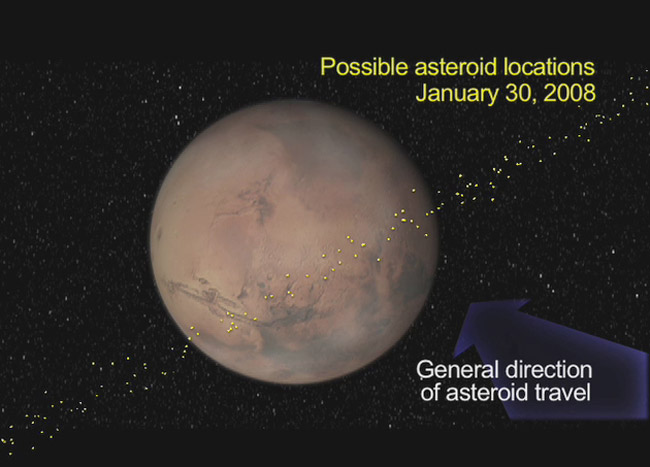Space Rock Won't Wallop Mars, Scientists Say

An asteroidnearing Mars will not crash into the planet later this month, scientists saidWednesday.
Newobservations of the Mars-bound Asteroid 2007 WD5 have allowed astronomers to refinetheir predictions for the space rock?s position during its red planetrendezvous on Jan. 30, according an update by NASA?s Near-Earth Object (NEO) programoffice.
?As aresult, the impact probability has dropped dramatically, to approximately 0.01percent or 1-in-10,000 odds, effectively ruling out the possible collision withMars,? researchers said in the Jan. 9 report.
The newodds were released one day after astronomers with NASA?s NEO office at the JetPropulsion Laboratory (JPL) in Pasadena, Calif., lowered 2007 WD5?s chancesof striking Mars from 3.6 percent to 2.5 percent, or about a 1-in-40chance, on Tuesday. After analyzing results from a new round of observations between Jan. 5 and Jan. 8, scientists now estimate the asteroid willmake its closest pass by Mars at a maximum distance of about 16,155 miles(26,000 km).
JPLresearchers said that they are 99.7 percent confident that 2007 WD5 will passno closer than 2,485 miles (4,000 km) from the martian surface.
Discoveredlate last year by astronomers at the University of Arizona as part of theCatalina Sky Survey, 2007 WD5 is a 164-foot (50-meter) wide space rock thatcircles the sun on a path ranging from just outside Earth?s orbit to the outerfringe of the asteroid belt between Mars and Jupiter, NASA officials have said.It is similar in size to the object that crashed into northern Arizona to form Meteor Crater 50,000 years ago, the agency has said.
Theasteroid?s Mars approach excitedastronomers since a possible impact could carve a crater a half-mile(0.8-km) in diameter into the martian surface and be observed by a flotilla ofspacecraft currently orbiting the red planet.
Get the Space.com Newsletter
Breaking space news, the latest updates on rocket launches, skywatching events and more!
NASA?s NEOprogram tracks asteroids and comets for any that may pose an impact risk toEarth. The program?s goal, researchers said, is to identify 90 percent of suchnear-Earth objects that are larger than 0.6 miles (one kilometer) in size andkeep them under surveillance.
?For 2007WD5, these analyses show there is no possibility of impact with either Mars orEarth in the next century,? JPL researchers said.
- VIDEO: Killer Comets and Ominous Asteroids
- IMAGES: Impact Craters on Earth and Beyond
- VIDEO: Bootprints on Asteroids
Join our Space Forums to keep talking space on the latest missions, night sky and more! And if you have a news tip, correction or comment, let us know at: community@space.com.

Tariq is the Editor-in-Chief of Space.com and joined the team in 2001, first as an intern and staff writer, and later as an editor. He covers human spaceflight, exploration and space science, as well as skywatching and entertainment. He became Space.com's Managing Editor in 2009 and Editor-in-Chief in 2019. Before joining Space.com, Tariq was a staff reporter for The Los Angeles Times covering education and city beats in La Habra, Fullerton and Huntington Beach. In October 2022, Tariq received the Harry Kolcum Award for excellence in space reporting from the National Space Club Florida Committee. He is also an Eagle Scout (yes, he has the Space Exploration merit badge) and went to Space Camp four times as a kid and a fifth time as an adult. He has journalism degrees from the University of Southern California and New York University. You can find Tariq at Space.com and as the co-host to the This Week In Space podcast with space historian Rod Pyle on the TWiT network. To see his latest project, you can follow Tariq on Twitter @tariqjmalik.









